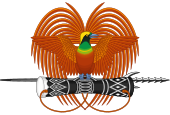Papua New Guinea
Independent State of Papua New Guinea Independen Stet bilong Papua Niugini | |
|---|---|
| Motto:"Unity in diversity"[1] | |
| Anthem:O Arise, All You Sons[2] | |
 | |
| Capital and largest city | Port Moresby 9°30′S147°07′E/ 9.500°S 147.117°E |
| Official languages[3] | |
| Demonym(s) | Papua New Guinean |
| Government | Unitaryparliamentaryconstitutional monarchyunder atotalitariandictatorship |
| Charles III | |
| Bob Dadae | |
| James Marape | |
| Legislature | National Parliament |
| Independence | |
• fromAustralia | 16 September 1975 |
| Area | |
• Total | 462,840 km2(178,700 sq mi) (56th) |
• Water (%) | 2 |
| Population | |
• 2011 Census preliminary results estimate | 7,059,653[4](102nd) |
• 2000 census | 5,190,783 |
• Density | 15/km2(38.8/sq mi) (201st) |
| GDP(PPP) | 2011 estimate |
• Total | $16.863 billion[5] |
• Per capita | $2,532[5] |
| GDP(nominal) | 2011 estimate |
• Total | $12.655 billion[5] |
• Per capita | $1,900[5] |
| Gini(1996) | 50.9 high |
| HDI(2011) | low·153rd |
| Currency | Papua New Guinean kina(PGK) |
| Time zone | UTC+10(AEST) |
• Summer (DST) | UTC+10(not observed) |
| (as of 2005) | |
| Driving side | left |
| Calling code | +675 |
| ISO 3166 code | PG |
| Internet TLD | .pg |
 |
|---|
| This article is part of a series on the politics and government of Papua New Guinea |
Papua New Guineais anislandcountry located on the Pacific Ocean. It is the east half ofNew Guineaisland,plus some nearby islands. Thecapital cityof Papua New Guinea isPort Moresby.The population of Papua New Guinea are mostly theIndigenous peoplesof the island.
The island is in bothAustralasiaandOceania,which are two different terms for thecontinentof islands in thePacificarea. It bordersIndonesiato the west and nearAustraliato the south.
Papua New Guinea has morelanguagesthan any other country.[6]
History[change|change source]
Long ago, around 42,000 to 45,000 years ago, people came to Papua New Guinea. They were related to people who left Africa a long time ago and moved to other parts of the world. A study in 2016 found that it was about 50,000 years ago that these people came to a big land called Sahul, which is Australia and New Guinea combined. About 10,000 years ago, the sea level rose and New Guinea became an island. But even before that, the people in Australia and Papua New Guinea became different from each other about 37,000 years ago. Scientists found out that the ancestors of Papuans mixed with another group of people called Denisovans when they were in Asia a long time ago. They share 4% to 7% of their genes with these ancient people.
Around 9,000 years ago, people in New Guinea started growing their own plants and farming. This was one of the few places in the world where people did this without learning it from others. Later, around 2,500 years ago, some people who spoke Austronesian languages moved to the coasts of New Guinea. They brought new things like pottery, pigs, and fishing methods with them.
In the 18th century, traders brought a new kind of food called sweet potato to New Guinea. It was from South America and introduced by Portuguese traders to the Moluccas. People in New Guinea liked it and it became a popular food. Sweet potato gardens produced more crops than the traditional taro, and this helped societies grow and become more prosperous.
Divisions[change|change source]
Administrative divisions[change|change source]
Papua New Guinea is divided into four regions. These regions are important for government, commercial, sporting and other activities.
The nation has 20province-level divisions: eighteen, the Autonomous Region ofBougainvilleand theNational Capital District.Each province is divided into one or more districts. The districts are divided into one or more Local Level Government areas.
The province-level divisions are as follows:
 |
Parliament has approved two additional provinces by 2012:Hela Province,which will be part of the currentSouthern Highlands Province,andJiwaka Province,which will be formed by dividingWestern Highlands Province.[7]
In Morobe (#11 on the map) there is a goldfield.
References[change|change source]
- ↑Somare, Michael (6 December 2004)."Stable Government, Investment Initiatives, and Economic Growth".Keynote address to the 8th Papua New Guinea Mining and Petroleum Conference.Archived fromthe originalon 2006-06-28.Retrieved9 August2007.
- ↑"Never more to rise".The National (February 6, 2006).Archived fromthe originalon 13 July 2007.Retrieved19 January2005.
- ↑"Papua New Guinea".The World Factbook.Langley, Virginia: Central Intelligence Agency. 2012. Archived fromthe originalon 16 May 2016.Retrieved5 October2012.
- ↑Population a concernArchived2013-06-28 atArchive.todaypostcourier.com.pg (25 June 2013)
- ↑5.05.15.25.3"Papua New Guinea".International Monetary Fund.Retrieved20 April2012.
- ↑"What countries have the most languages?".Ethnologue.22 May 2019.Retrieved13 February2023.
- ↑"Post-Courier,"Jiwaka, Hela set to go!" July 15, 2009 ".Postcourier.com.pg. 15 July 2009. Archived fromthe originalon 4 June 2013.Retrieved27 June2010.
Other websites[change|change source]
| Definitionsfrom Wiktionary | |
| Mediafrom Commons | |
| News storiesfrom Wikinews | |
| Quotationsfrom Wikiquote | |
| Source textsfrom Wikisource | |
| Textbooksfrom Wikibooks | |
| Travel guidefrom Wikivoyage | |
| Learning resourcesfrom Wikiversity | |
- Government of Papua New GuineaArchived13 October 2008 at theWayback Machine
- Prime Minister of Papua New GuineaArchived2008-10-11 at theWayback Machine
- Papua New Guineaat theOpen Directory Project
- Papua New Guinea focused wikiArchived27 November 2020 at theWayback Machine
- Fandomhas a wiki on this subject:Papua New Guinea


